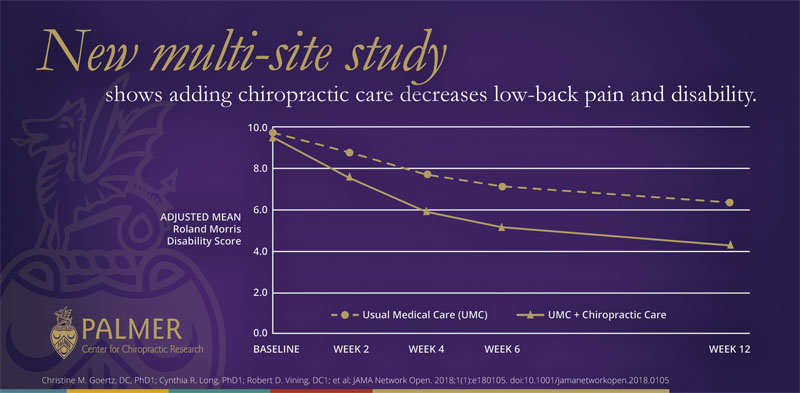Effect of Usual Medical Care Plus Chiropractic Care vs Usual
Effect of Usual Medical Care Plus Chiropractic Care vs Usual Medical Care Alone
on Pain and Disability Among US Service Members With Low Back Pain.
A Comparative Effectiveness Clinical Trial
SOURCE: JAMA Network Open. 2018 (May 18); 1 (1): e180105
Christine M. Goertz, DC, PhD 1; Cynthia R. Long, PhD 1; Robert D. Vining, DC 1; Katherine A. Pohlman, DC, MS 2; Joan Walter, JD, PA 3; Ian Coulter, PhD 4
(1) Palmer College of Chiropractic,
Palmer Center for Chiropractic Research,
Davenport, Iowa
(2) Parker University Research Institute,
Dallas, Texas
(3) Samueli Institute for Information Biology,
Silver Spring, Maryland
(4) RAND Corporation,
Santa Monica, California
Importance It is critically important to evaluate the effect of nonpharmacological treatments on low back pain and associated disability.
Objective To determine whether the addition of chiropractic care to usual medical care results in better pain relief and pain-related function when compared with usual medical care alone.
Design, Setting, and Participants A 3–site pragmatic comparative effectiveness clinical trial using adaptive allocation was conducted from September 28, 2012, to February 13, 2016, at 2 large military medical centers in major metropolitan areas and 1 smaller hospital at a military training site. Eligible participants were active-duty US service members aged 18 to 50 years with low back pain from a musculoskeletal source.
Interventions The intervention period was 6 weeks. Usual medical care included self-care, medications, physical therapy, and pain clinic referral. Chiropractic care included spinal manipulative therapy in the low back and adjacent regions and additional therapeutic procedures such as rehabilitative exercise, cryotherapy, superficial heat, and other manual therapies.
Main Outcomes and Measures Coprimary outcomes were low back pain intensity (Numerical Rating Scale; scores ranging from 0 [no low back pain] to 10 [worst possible low back pain]) and disability (Roland Morris Disability Questionnaire; scores ranging from 0–24, with higher scores indicating greater disability) at 6 weeks. Secondary outcomes included perceived improvement, satisfaction (Numerical Rating Scale; scores ranging from 0 [not at all satisfied] to 10 [extremely satisfied]), and medication use. The coprimary outcomes were modeled with linear mixed-effects regression over baseline and weeks 2, 4, 6, and 12.
Results Of the 806 screened patients who were recruited through either clinician referrals or self-referrals, 750 were enrolled (250 at each site). The mean (SD) participant age was 30.9 (8.7) years, 175 participants (23.3%) were female, and 243 participants (32.4%) were nonwhite. Statistically significant site × time × group interactions were found in all models. Adjusted mean differences in scores at week 6 were statistically significant in favor of usual medical care plus chiropractic care compared with usual medical care alone overall for low back pain intensity (mean difference, –1.1; 95% CI, –1.4 to –0.7), disability (mean difference, –2.2; 95% CI, –3.1 to –1.2), and satisfaction (mean difference, 2.5; 95% CI, 2.1 to 2.8) as well as at each site. Adjusted odd ratios at week 6 were also statistically significant in favor of usual medical care plus chiropractic care overall for perceived improvement (odds ratio = 0.18; 95% CI, 0.13–0.25) and self-reported pain medication use (odds ratio = 0.73; 95% CI, 0.54–0.97). No serious related adverse events were reported.
There are more articles like this @ our:
Chiropractic Care For Veterans Page and the:


